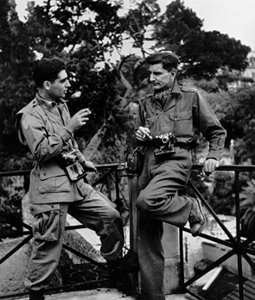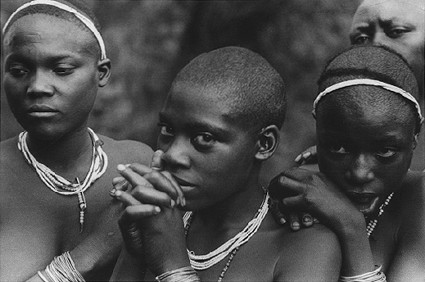 |
December
1999
an exhibition at the Barry Singer Gallery in Petaluma, CA
photographs by George Rodger
exhibition curated by Barry Singer
While his colleagues and co-founders of Magnum Photos Henri
Cartier-Bresson, Robert Capa and David "Chim" Seymour are famous
in this country, George Rodger, the fourth musketeer, a great
photojournalist who started working professionally in the London
Blitz, is little known here.
This wonderful exhibit organized by the Barry Singer Gallery
in Petaluma, north of San Francisco, is a beginning to redress
this injustice. The space itself, a ball-room under the cupola
of a turn-of-the-century historic building, the varied choice
of frames and the diversity of formats lend the exhibit a different
"feel" than that of a scholarly museum presentation and are
particularly well-suited to the photographer's spirit.
Through 61 vintage prints spread out in three rooms, the exhibit
traces important aspects of Rodger's career from the London
Blitz to his early African trips after the war (Rodger was the
first to enter Bergen-Belsen but after this traumatic experience
vowed that he never again would be a war photographer). It proceeds
with desert and tribal photographs taken on the numerous expeditions
he made with his wife and collaborator Jinx in Africa (where
they met Doctor Schweitzer), the Sahara desert and the Middle
East, and finishes with a group of seldom-seen prints from Burma
and Bali together with a stunning group of pictures made on
Rodger's last African trip in 1980-81, when he photographed
the circumcision of a Masai adolescent in Kenya, a ceremony
never before or after witnessed by a white man.
|

War correspondants
Robert Capa (left) and George Rodger in Vomero, Italy, 1943.
|
|

Three Bachimbiri girls, 1948 |
Rodger,
who died in 1995, was a modest man who did not view himself
as an artist. He would be surprised to see his prints analyzed
and praised for their classic composition and subtle light as
he was interested foremost in those whose trust he earned and
who let him work freely in the most remote parts of the earth.
Images such as the Pygmies of the rain forest in Uganda, absorbed
in their love dance, the rainmaking dance of the Latukas in
Southern Sudan or the famous image of the Nuba warrior carried
over his adversary's shoulders remain etched in the mind and
make for a memorable showing.
For books of Rodger's work, see:
- George Rodger Photographic Voyager, exhibition catalogue,
Barry Singer Publishers, 1999
- George
Rodger: Humanity and Inhumanity, Phaidon, 1995, repub. 1999
- Village
of the Nubas, Phaidon, 1999
|

|
|



